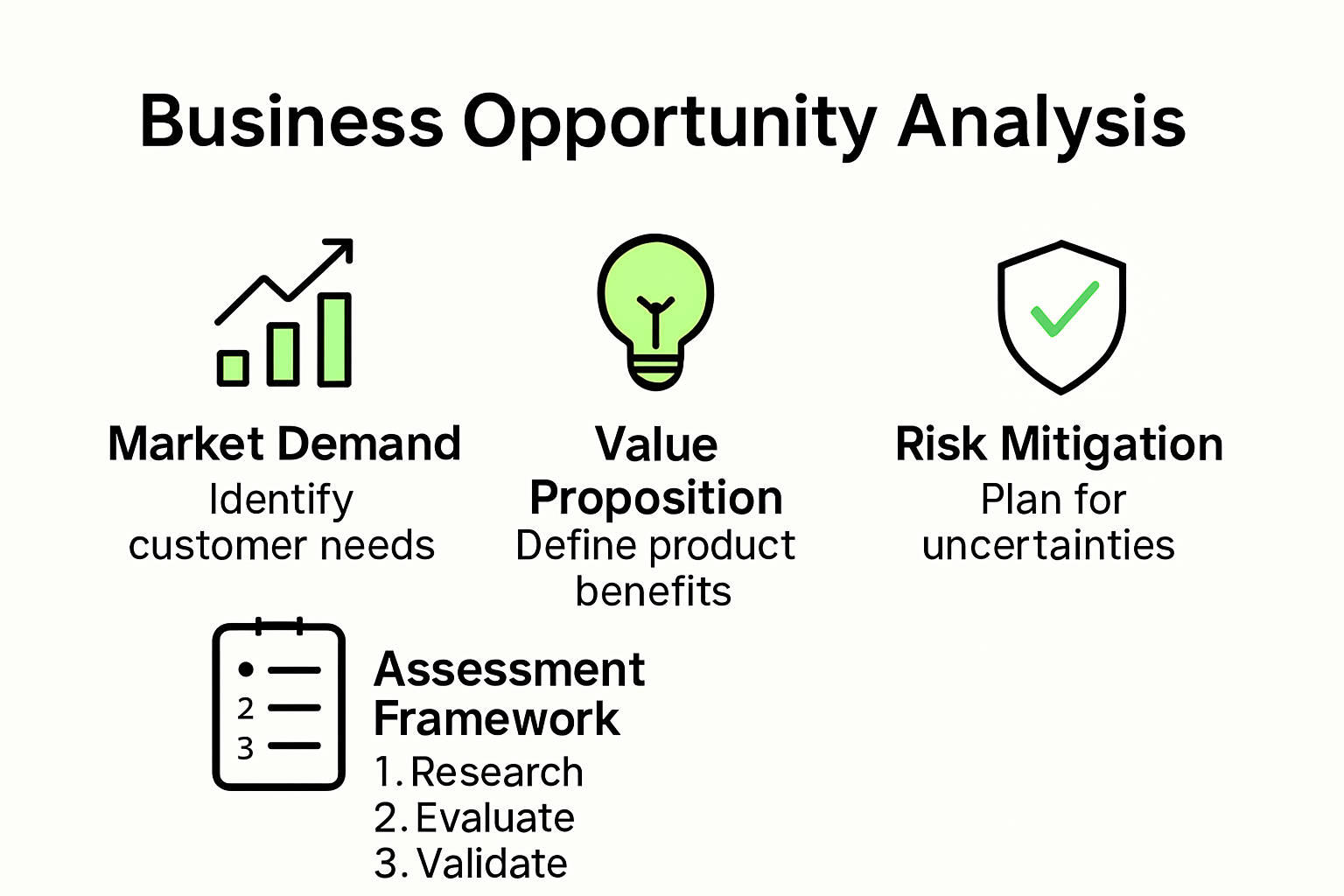
Business Opportunity Analysis for First-Time Founders 2025
First-time founders have bold ideas, but turning a spark into a real business takes more than just ambition. Nearly 35 percent of startups fail because there’s no real market need for their product. That sounds shocking, right? Most surprising of all, the tools to spot winning ideas are simple and right at your fingertips—if you know how to use them.
Table of Contents
- Understanding Business Opportunity Analysis
- What Defines A Business Opportunity
- Systematic Opportunity Assessment Framework
- Risk Evaluation And Mitigation Strategies
- Key Steps To Analyze Your Business Idea
- Market Research And Customer Discovery
- Prototype Development And Validation
- Financial Feasibility Assessment
- Tools And Frameworks For Beginners
- Strategic Analysis Frameworks
- Digital Research And Validation Tools
- Financial Modeling And Projection Frameworks
- Real Examples And Common Mistakes To Avoid
- Success Stories Of Pivotal Business Opportunity Analysis
- Critical Mistakes That Derail Business Opportunities
- Risk Mitigation Strategies
Quick Summary
Understanding Business Opportunity Analysis
Business opportunity analysis represents a critical strategic process for first-time founders seeking to transform innovative ideas into viable commercial ventures. This methodical approach helps entrepreneurs evaluate the potential success and feasibility of a business concept before investing significant resources.

What Defines a Business Opportunity
A genuine business opportunity emerges at the intersection of market demand, unique value proposition, and executable strategy. Harvard Business Review suggests that successful opportunities typically demonstrate three fundamental characteristics: scalable market potential, addressable customer pain points, and competitive differentiation.
Entrepreneurs must critically assess whether their concept solves a meaningful problem for a specific target audience. This involves deep market research, understanding customer segments, and identifying gaps that existing solutions fail to address. Market validation becomes crucial - confirming that potential customers are willing to pay for the proposed solution.
To clarify the essential characteristics of genuine business opportunities, see the summary table below:
Systematic Opportunity Assessment Framework
Effective business opportunity analysis follows a structured evaluation process. MIT Sloan Management Review recommends a comprehensive framework that includes:
- Market Size Assessment: Quantifying the total addressable market and potential revenue streams
- Customer Validation: Conducting direct research and gathering feedback from potential users
- Competitive Landscape Analysis: Understanding existing solutions and identifying unique positioning
Successful founders recognize that opportunity analysis is not a one-time event but an ongoing process of refinement. They remain adaptable, continuously gathering market intelligence and adjusting their strategy based on emerging insights.
Risk Evaluation and Mitigation Strategies
Business opportunity analysis goes beyond identifying potential. It requires a rigorous examination of potential risks and challenges. Entrepreneurs must develop realistic scenarios that could impact their venture’s success, creating contingency plans and understanding potential obstacles.
This approach transforms opportunity analysis from a theoretical exercise into a pragmatic roadmap. By systematically breaking down market dynamics, customer needs, and potential challenges, founders can make informed decisions that significantly improve their chances of building a sustainable business.
Ultimately, business opportunity analysis serves as a founder’s strategic compass - guiding decision making, reducing uncertainty, and providing a structured approach to transforming innovative ideas into successful entrepreneurial ventures.
Key Steps to Analyze Your Business Idea
Transforming a business idea from concept to potential reality requires a strategic and methodical approach. Founders must navigate a complex landscape of market research, validation, and critical assessment to determine the viability of their entrepreneurial vision.
Market Research and Customer Discovery
The first critical step in analyzing a business idea involves comprehensive market research. Stanford Graduate School of Business recommends a systematic approach to understanding potential customer needs and market dynamics. This process goes beyond surface-level observations, requiring founders to conduct deep investigative work.
Effective market research involves multiple layers of investigation:
- Direct Customer Interviews: Engaging potential users to understand their pain points and challenges
- Competitive Landscape Analysis: Mapping existing solutions and identifying market gaps
- Trend Research: Examining industry shifts and emerging opportunities
Entrepreneurs should aim to develop a nuanced understanding of their target market, moving beyond assumptions to gather concrete insights. Customer discovery becomes a critical process of validating whether the proposed solution genuinely addresses a meaningful problem.

Prototype Development and Validation
Y Combinator emphasizes the importance of creating a minimum viable product (MVP) to test business concepts. This approach allows founders to gather real-world feedback with minimal resource investment. The MVP serves as a practical tool for validating core assumptions and understanding potential market reception.
The prototype validation process typically involves:
- Building a basic version of the product or service
- Testing with a small group of potential customers
- Collecting detailed feedback and performance metrics
- Iterating based on real-world insights
Financial Feasibility Assessment
Beyond market and product validation, founders must conduct a rigorous financial analysis. This step involves critically examining the economic viability of the business idea, including potential revenue streams, cost structures, and financial sustainability.
Key financial considerations include:
- Revenue Model: Identifying how the business will generate income
- Cost Structure: Analyzing initial and ongoing expenses
- Potential Profitability: Projecting financial performance and break-even points
Successful founders approach this analysis with brutal honesty, willing to pivot or abandon ideas that do not demonstrate strong financial potential. The goal is not just to have a good idea, but to create a sustainable business model that can generate meaningful value.
Analyzing a business idea is an iterative process that requires continuous learning, adaptation, and critical thinking. It demands founders move beyond emotional attachment to their concept and instead approach their idea with a strategic, objective lens. By systematically validating market need, product potential, and financial feasibility, entrepreneurs can significantly increase their chances of building a successful venture.
Below is a table outlining each key step in analyzing a business idea and its main purpose:
Tools and Frameworks for Beginners
Navigating the complex world of business opportunity analysis can be overwhelming for first-time founders. Fortunately, numerous tools and frameworks have been developed to simplify the process and provide structured guidance for entrepreneurs at the beginning of their journey.
Strategic Analysis Frameworks
Business Model Canvas emerges as a powerful tool for entrepreneurs to visualize and prototype their business models. Harvard Business Review highlights its effectiveness in breaking down complex business concepts into digestible components.
Key frameworks that beginners should consider include:
- SWOT Analysis: Evaluating Strengths, Weaknesses, Opportunities, and Threats
- Porter’s Five Forces: Understanding competitive landscape and industry dynamics
- Lean Startup Methodology: Developing iterative product development and market testing approaches
These frameworks provide a structured approach to analyzing business opportunities, helping founders move beyond intuition to data-driven decision making. Strategic thinking becomes more accessible when entrepreneurs have clear tools to dissect their business concept.
Digital Research and Validation Tools
Product Hunt offers a range of digital tools that can support business opportunity analysis. Modern entrepreneurs have access to powerful resources that were unavailable just a decade ago:
- Market Research Platforms: Google Trends, SimilarWeb for understanding market dynamics
- Customer Feedback Tools: UserTesting, SurveyMonkey for gathering direct customer insights
- Competitive Intelligence: SEMrush, Ahrefs for analyzing market positioning
These digital tools democratize market research, allowing founders with limited resources to gather sophisticated insights. The key is using these tools strategically, understanding their strengths and limitations.
Financial Modeling and Projection Frameworks
Financial analysis represents a critical component of opportunity assessment. Startup Financial Modeling Guide recommends several approaches for beginners to create robust financial projections:
- Developing detailed revenue and expense spreadsheets
- Creating multiple scenario models (best case, worst case, most likely)
- Understanding key financial metrics and performance indicators
Founders should approach financial modeling as a dynamic process. The initial model serves as a starting point, not a definitive prediction. Successful entrepreneurs continuously refine their financial projections based on new market insights and real-world performance.
Navigating business opportunity analysis requires a combination of strategic frameworks, digital tools, and financial modeling techniques. While these resources provide valuable guidance, the most important ingredient remains the founder’s critical thinking and willingness to adapt. Tools and frameworks are most effective when used as supportive mechanisms, not rigid prescriptions.
Entrepreneurs who approach these tools with curiosity, flexibility, and a commitment to continuous learning will be best positioned to transform their innovative ideas into successful business ventures.
Real Examples and Common Mistakes to Avoid
Entrepreneurial journeys are often marked by critical learning moments that can make or break a business opportunity. Understanding real-world examples and potential pitfalls provides invaluable insights for first-time founders navigating the complex landscape of business development.
Success Stories of Pivotal Business Opportunity Analysis
Forbes highlights several compelling narratives of successful entrepreneurs who mastered business opportunity analysis. Take the example of Slack, which began as a completely different product an internal communication tool for a gaming company before recognizing its true market potential.
Key lessons from successful pivots include:
- Flexibility: Being willing to dramatically reshape the original business concept
- Market Listening: Paying close attention to unexpected user feedback
- Rapid Iteration: Quickly testing and implementing changes based on real-world insights
Adaptability emerges as the most critical factor in transforming a potential business failure into a breakthrough opportunity. Successful founders demonstrate an ability to separate emotional attachment from strategic thinking.
Critical Mistakes That Derail Business Opportunities
CB Insights provides a comprehensive analysis of why startups fail, revealing patterns that first-time founders must carefully navigate. The most common mistakes include:
- Misreading market demand
- Overlooking financial sustainability
- Neglecting customer feedback
- Scaling prematurely before proving core business viability
One recurring theme stands out: founders often fall in love with their idea rather than the problem they’re trying to solve. This emotional attachment can blind entrepreneurs to critical market signals and potential pivots.
For a quick overview, the table below summarizes major mistakes that commonly derail business opportunities:
Risk Mitigation Strategies
Navigating business opportunities requires a balanced approach of enthusiasm and critical analysis. Successful founders develop a systematic approach to risk assessment:
- Conduct extensive market research before significant investments
- Create multiple scenario plans
- Develop a minimum viable product to test core assumptions
- Maintain financial flexibility
- Build a network of mentors and advisors
The most successful entrepreneurs view mistakes not as failures but as essential learning opportunities. Inc. Magazine emphasizes that each setback provides critical insights that can ultimately strengthen the business concept.
Business opportunity analysis is not about achieving perfection but about developing a resilient, adaptive approach to entrepreneurship. The most valuable skill is not avoiding mistakes entirely but learning to recognize, respond to, and leverage them effectively.
Ultimately, the journey of analyzing and developing a business opportunity is as important as the final outcome. Founders who approach their ventures with curiosity, humility, and a commitment to continuous learning are most likely to transform initial challenges into sustainable success.
Frequently Asked Questions
What is business opportunity analysis?
Business opportunity analysis is a systematic approach used by first-time founders to evaluate the feasibility and potential success of a business idea before committing resources.
How can first-time founders identify genuine business opportunities?
First-time founders can identify genuine opportunities by assessing market demand, recognizing customer pain points, and ensuring competitive differentiation through thorough market research.
What are the key steps in analyzing a business idea?
The key steps include market research and customer discovery, prototype development and validation, and financial feasibility assessment to determine viability and potential profitability.
What tools can beginners use for business opportunity analysis?
Beginners can utilize strategic analysis frameworks like SWOT analysis and the Business Model Canvas, along with digital research tools such as Google Trends and customer feedback platforms to gather insights.
Ready to Turn Your Business Idea Into Reality?
Struggling to confidently validate your business opportunity or worried about making some common first-time founder mistakes? This article highlights how difficult it can feel to conduct market research, validate customer need, and avoid emotional bias. Dreaming up a business is only the first step. Getting objective feedback, actionable insights, and a systematic approach—like developing your minimum viable product and running financial analysis—can be overwhelming and isolating.
Experience a smarter way to build your startup idea with siift. Our intuitive AI platform guides you step-by-step with personalized feedback and proven frameworks like customer discovery and SWOT analysis. Discover hidden risks before they become real roadblocks. Cut through confusion and make every move count. Don’t wait to validate your potential—start your founder journey with siift today.

see where you stand





.svg)
.svg.png)



.svg)

